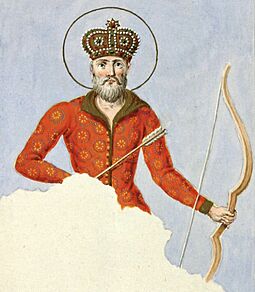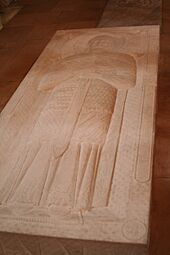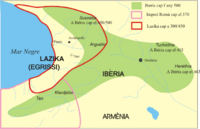Vakhtang I facts for kids
Quick facts for kids Vakhtang I Gorgasali |
|
|---|---|

A miniature by Pier Rossi based on the 17th century fresco of Vakhtang from Svetitskhoveli Cathedral
|
|
| 32nd King of Iberia (more...) | |
| Reign | c. 447/49 – 502/22 |
| Predecessor | Mihrdat V |
| Successor | Dachi |
| Born | c. 439/43 Mtskheta, Kingdom of Iberia, Sasanian Empire |
| Died | c. 502/22 (aged 62–63 or 78-79) Ujarma, Kingdom of Iberia, Sasanian Empire |
| Burial | Mtskheta, Svetitskhoveli Cathedral |
| Spouse | Balendukht Elene |
| Issue | Dachi Leon Mihrdat Two anonymous daughters |
| Dynasty | Chosroid dynasty |
| Father | Mihrdat V |
| Mother | Sagdukht |
| Religion | Georgian Orthodox Church |
Vakhtang I Gorgasali (Georgian: ვახტანგ I გორგასალი, romanized: vakht'ang I gorgasali; born around 439 or 443 – died around 502 or 522) was a powerful king of Iberia. This kingdom, known as Kartli to its people, was in eastern Georgia. Vakhtang belonged to the Chosroid dynasty. He ruled in the late 400s and early 500s.
King Vakhtang led his people in a long fight against the Sasanian Iranian Empire. He teamed up with the Byzantine Empire. However, this alliance did not go well, and Vakhtang's kingdom became weaker. People also believe he helped organize the Georgian Orthodox Church. He is also famous for founding Tbilisi, which is Georgia's capital city today.
Vakhtang is a hero in an old story called the Life of Vakhtang Gorgasali. This story mixes history with legends. It makes Vakhtang seem like a super-strong warrior-king and a great leader. Because of this story, people still see him as a brave and important figure in Georgian history. The Georgian Orthodox Church even made him a saint. He is known as The Holy and Right-Believing King Vakhtang.
Contents
What's in a Name?
The Life of Vakhtang Gorgasali says the king's birth name was Varazkhosrovtang. This name came from the Iranian language. It means "wolf-bodied." This might show that ancient Georgians respected wolves. Later, many Georgian princes and kings used the name Vakhtang.
The king also had a nickname: Gorgasal. He got this name because of the special shape of his helmet. Some historians think a Roman historian named Procopius called him Gurgenes. This is because "Gurgenes" might be how "Gorgasal" sounded in Greek. However, not everyone agrees that Vakhtang and Gurgenes were the same person.
Early Years as King
Old Georgian writings don't say much about Vakhtang. But they always speak of him with great respect. The Life of Vakhtang Gorgasali (LVG) tells us many important details. We can combine these details with other historical records to learn more.
The LVG says Vakhtang became king when he was only 7 years old. His father was King Mihrdat (V). Vakhtang's mother, Sagdukht, was a Christian Persian. She ruled the kingdom while Vakhtang was too young. Iberia faced many problems then. The Sasanian Empire tried to make them follow their religion, Zoroastrianism. Also, "Ossetians" from the north attacked the land. These attackers might have been Huns.
When Vakhtang was 16, he led his army against the "Ossetians." He won a big battle and even defeated a giant enemy in a single combat. He also rescued his sister, Mirandukht, who had been captured. At 19, Vakhtang married Balendukht. She was the "daughter" of the Great King Hormizd, likely Hormizd III.
Later, the Great King asked Vakhtang to join a war in "India." This was probably a campaign against the Hephthalites in the 460s. Vakhtang also fought against the Roman Empire in 472. During this time, he gained control of Egrisi (Lazica) and Abkhazia.
Changes in the Church
After returning to Iberia, Vakhtang worked to make his royal power stronger. He didn't like how much the Iranian Empire tried to control his kingdom. So, he changed his alliances and became friends with the Roman government.
He married Helena, who was related to Emperor Zeno. Vakhtang also got permission from Constantinople to make the head of the Iberian church more powerful. The bishop of Mtskheta became a catholicos. Vakhtang sent him and twelve new bishops to be consecrated in Antioch. These changes were not easy. Vakhtang had to overcome opposition, especially from Mikel, the old bishop of Mtskheta.
Fighting the Iranian Empire
Vakhtang's pro-Roman policy made his own nobles unhappy. They wanted Iran's support against the king's growing power. In 482, Vakhtang killed his most powerful noble, Varsken. Varsken had converted to Zoroastrianism and supported Iran in the Caucasus. He had also killed his Christian wife, Shushanik. Shushanik was a hero in early Georgian literature.
By killing Varsken, Vakhtang openly challenged his Iranian overlord. Vakhtang asked Armenian princes and the Huns to help him. The Armenians, led by Vahan Mamikonian, joined Vakhtang. But the allies lost the battle. Iranian armies attacked Iberia in 483 and 484. Vakhtang had to escape to Roman-controlled Lazica.
After the Iranian king Peroz died in 484, his successor Balash made peace in the Caucasus. Vakhtang could return to rule Iberia. But he still supported the Roman Empire.
Later, the peace between Iran and Rome ended. The Sasanian king Kavadh I ordered Vakhtang to join his new war against Rome. Vakhtang refused. This caused Iran to invade his kingdom. Vakhtang was about 60 years old. He spent his last years fighting and in exile. He tried to get help from Rome, but it didn't work.
By 518, an Iranian governor was in charge of Tiflis. This city was founded by Vakhtang, according to Georgian tradition. It later became the capital. The LVG says Vakhtang died fighting an Iranian army. A slave shot him through a weak spot in his armor. The wounded king was taken to his castle at Ujarma. He died there and was buried in the cathedral in Mtskheta. Some historians believe he died around 502. Others think he might have died around 522 in Lazica.
Vakhtang's Family
The LVG says Vakhtang had three sons. His oldest son, Dachi, became king after him. Dachi was from Vakhtang's first marriage to the Iranian princess Balendukht. Dachi had to become loyal to Iran again.
Vakhtang had two younger sons with his second wife, the Roman lady Elene. Their names were Leon and Mihrdat. They were given control of the southwestern Iberian regions. Leon's family, the Guaramids, usually supported Rome. Both these family lines continued in Iberia until the 700s. Later, their relatives, the Bagratid family, became powerful.
Vakhtang's Last Wishes
Before he died, King Vakhtang left a message for his son Dachi and all Georgians:
I, as I go to my God, I give thanks to His name, because he did not sacrifice [or: 'spare'] his chosen blessings. Now I tell you, that you stand strong in your faith and seek death for Christ in His name, so that you may gain endless glory!
He also told Georgians to stay friends with the Byzantine Empire:
I have made you and all my family great with glory; do not shame our home, and do not stop loving the Greeks.
Vakhtang's Legacy

Vakhtang became a legendary hero in Georgia a long time ago. The royal flag of the Georgian Bagratids was called "Gorgasliani," meaning "of Gorgasali." Some people think it was the first version of today's Georgian national flag.
In people's memories, Vakhtang is a romantic and legendary figure. Many folk poems and stories tell of his greatness. They praise his amazing physical strength, courage, and strong Christian faith.
Vakhtang is also believed to have founded several towns, castles, and monasteries in Georgia. This includes the capital city, Tbilisi. A street and a square in Tbilisi are named after him. There's also a monument to him on the Metekhi cliff, built in 1967. A famous legend says that King Vakhtang was hunting in the forest. His falcon chased a pheasant. The bird fell into a hot spring. The king and his servants saw steam rising from the water. Vakhtang was amazed by the hot water. He ordered a city to be built there and named it "Tbilisi," which means "the site of warm springs."
Vakhtang was officially added to the Georgian Orthodox calendar as a saint in the early 1990s. But people likely thought of him as a saint much earlier. The Vakhtang Gorgasal Order, created in 1992, is one of the highest military awards in Georgia.




